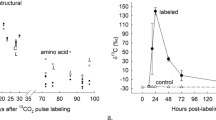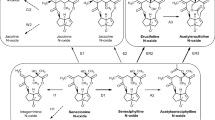Abstract.
Laboratory and field tracer experiments with 14C-labelled senecionine N–oxide (SO) and distant biosynthetic precursors such as [14C]putrescine revealed that pyrrolizidine alkaloid N-oxides (PAs) in Senecio vernalis Waldstr. & Kit. (Asteraceae) show no significant turnover over periods of up to 29 d. However, PAs are spatially mobile, they are continuously allocated, and labelled PAs are even detectable in leaves and capitula developed weeks after tracer application. Chemical diversification of SO, the common product of PA biosynthesis in roots, was studied in five Senecio species (i.e. S. vernalis Waldstr. & Kit., S. vulgaris L, S. inaequidens DC, two chemotypes of S. jacobaea L. and S. erucifolius L.). Tracer experiments revealed that shoots are capable of transforming [14 C]SO into the unique species–specific PA patterns. Within a plant, the transformation efficiency of SO can vary quantitatively and qualitatively between shoot organs (i.e. leaves, stems and inflorescences). All transformations proceed position-specifically and stereoselectively. They comprise simple one-step or two-step reactions such as hydroxylations, epoxidations, dehydrogenations, and O-acetylations, as well as the more complex conversion of the retronecine into the otonecine base moiety (e.g. SO into senkirkine). Taking all the evidence together, the qualitative and quantitative composition of the Senecio PA pattern is a dynamic and sensitive equilibrium between a number of interacting processes: (i) constant rate of de-novo synthesis of SO in roots, (ii) continuous long-distance translocation of SO into shoots, (iii) efficiency of SO transformations which may vary between plant organs, (iv) continuous allocation of PAs in the plant, and (v) efficiency and tissue selectivity of vacuolar storage. We suggest that in constitutive plant defence, without significant turnover of its components, such a highly plastic system provides a powerful strategy to successfully defend and possibly escape herbivory.
Similar content being viewed by others
Author information
Authors and Affiliations
Additional information
Received: 27 March 1998 / Accepted: 19 May 1998
Rights and permissions
About this article
Cite this article
Hartmann, T., Dierich, B. Chemical diversity and variation of pyrrolizidine alkaloids of the senecionine type: biological need or coincidence?. Planta 206, 443–451 (1998). https://doi.org/10.1007/s004250050420
Issue Date:
DOI: https://doi.org/10.1007/s004250050420




